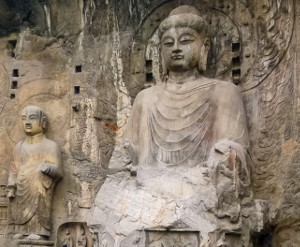Fascinated by history … glimpses into the past … legends and great feats unfold …
What are grottoes?
Picturesque caves … caverns … alcoves … recesses … hollowed out of mountains …or natural caves near water … landscape of limestone, dolomite and gypsum rock erosion …
Gesture to the Gods … sign of respect, humility, gratitude for prosperity … successful merchants, nobles and emperors commissioned these places of rest and worship along the Chinese Silk Road – accessed by journeymen, pilgrims seeking, sharing knowledge.
Discovery of numerous manuscripts, wall and ceiling inscriptions in these grottoes, including secret chambers preserved historical findings otherwise would have been destroyed in earthquakes, wars and civil uprisings.
There are 5 known man-made Grottoes in China – 3 UNESCO World Heritage listed and most visited are Yungang and Longmen Grottoes in eastern China and Magao Grotto in western China, bordering Mongolia and Gobi Desert.
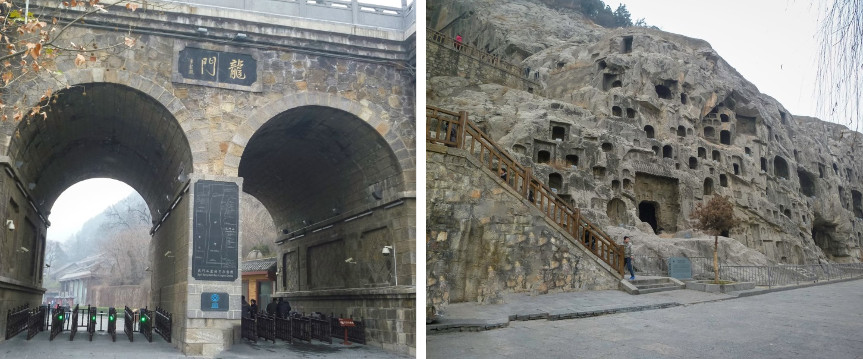
Longmen (Dragon’s Gate) Grottoes
Largest and most impressive collection of Chinese art of late Northern Wei and Tang Dynasties (316-907) are found in Longmen or Dragon’s Gate Grottoes. Devoted entirely to Buddhism; high point of Chinese stone carving.
Located on both sides of Yi River, in ancient capital of Luoyang, Henan province; boasting 2345 caves and niches in steep limestone cliffs, stretching over 1 km (0.621 mile) length. 110,000 Buddhist statues, ranging from 25cm (1inch) to 17metres (57 feet) in height; over 60 stupas (commemorative housing of sacred relics) and 2800 inscriptions carved on steles (stone or wooden slabs).
Carvings in “Northern Wei style” dated from end 5th century to mid-8th century are found in Guyangdong – oldest and largest cave. (“Dong” means cave in Mandarin).
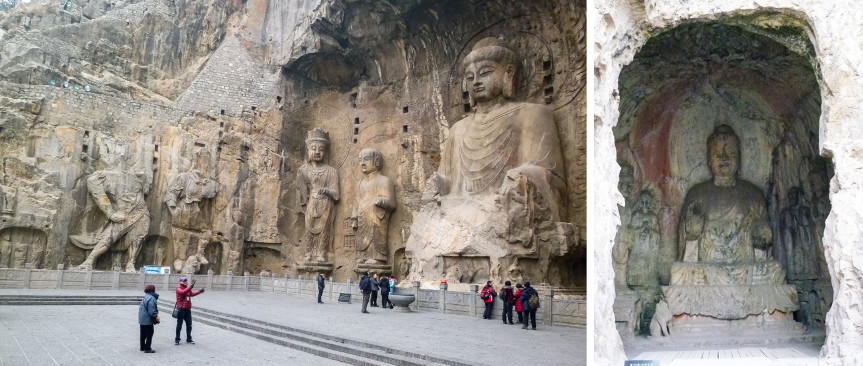
Fengxiandong, measuring 39 x 35metres (128 x 115feet) internally, housed the largest Buddha statue – image of Vairocana Buddha, 17metres (57feet) height with 2metre (6.6feet) long ears.
Image featured plump, peaceful, natural expression – uniquely represented Tang Dynasty’s “vigorous, elegant, realistic style”. It is considered as “the quintessence of Buddhist sculpture in China”.
Apart from statues, Yaofangdong housed 140 inscriptions recording treatments for various diseases and illnesses.
Intensive restoration, foundation strengthening, footpaths, railings and walkways now provide easy access to these magnificent structures.
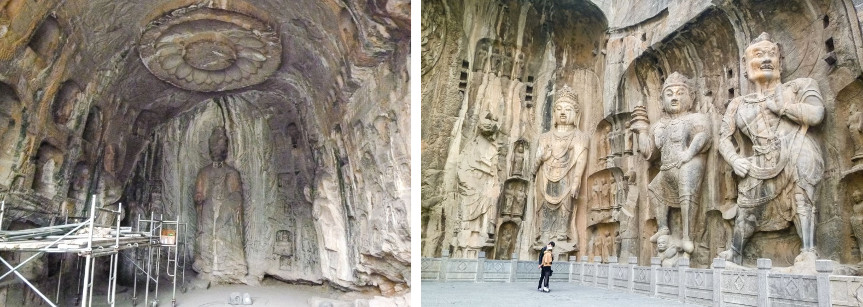
Sculptural styles represented “Central China style” and ‘Great Tang style” – influenced and contributed to sculptural arts in China and Asian countries.
Longmen Grottoes are “… a manifestation of human artistic creativity …Illustrated perfection of long-established art form of cultural evolution in Asia”… reflecting “high cultural level and sophisticated society of Tang Dynasty China” … encapsulated in stone.
Sculptures are hand-crafted, no modern or mechanical equipment.
Yungang Grottoes
Cloudless sky, sunny, barely warm morning; just minus 25⁰C (-77⁰F) – no crowds, no queues, peaceful and freezing as you gaze upon Yungang Grottoes’ 5th and 6th century stone carvings in ancient caves dotting hillside near Datong in Shanxi province.
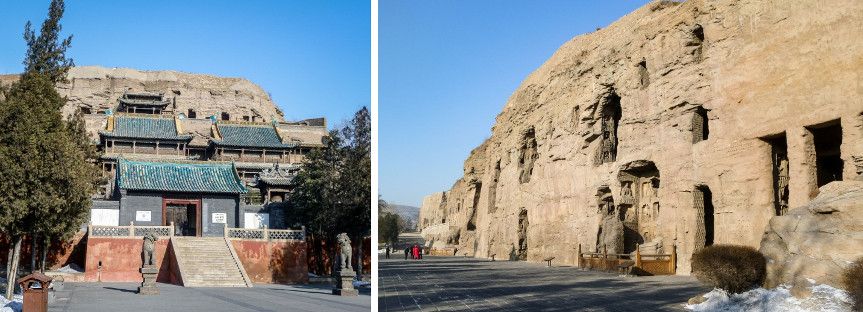
252 caves, 51,000 niches housing 51,000 Buddha statues, together with another 1100 minor caves topped with a Ming Dynasty-era fort.
Sandstone cliffs 792.4m (2600feet) length and 9 –18m (30-60feet) height; considered “… masterpiece of early Chinese Buddhist cave art … represent successful fusion of Buddhist religious symbolic art from south and central Asia with Chinese cultural traditions …”.
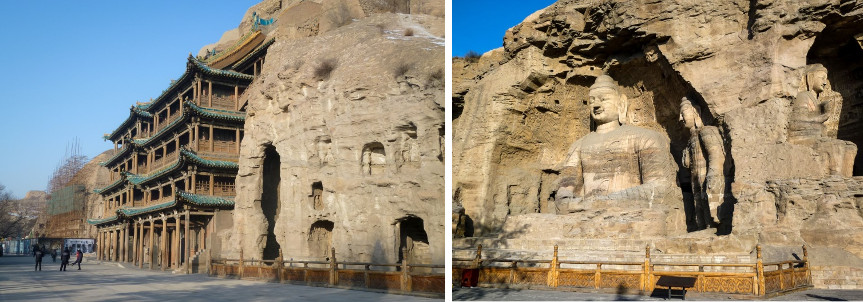
Caves and niches are in good condition, though weathered; no major damage from vandalism and/or natural disasters – serving as “one of greatest ancient stone carving art treasure houses in the world”.
Cave 6, surface area of about 1000 square meters is completely carved and painted – centered stupa pillar extending from floor to ceiling with carvings of standing Buddhas, Bodhisattvas, monks and celestial figures.
Magao Grottoes
Dunhuang, frontier garrison in 111BC, gateway to the West – centre of commerce and meeting place of various people and religions.
Magao Grottoes, also known as Thousand Buddha Grottoes, built 25km (16 miles) southeast of Dunhuang; 735 caves, 492 temples, an oasis of religious and cultural crossroad on the Chinese Silk Road in Gangsu province.
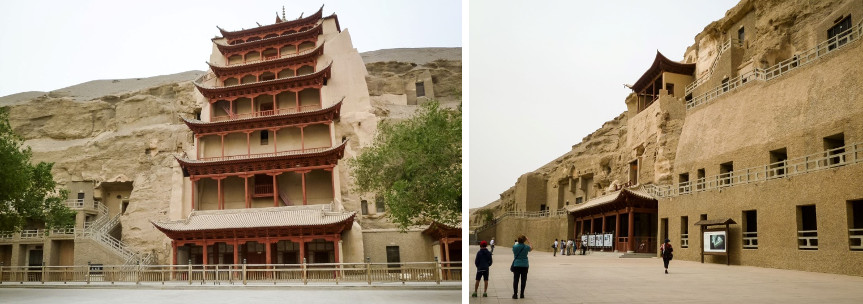
Constructed in 4th century AD for worship and pilgrimage; elaborately painted representations of quest for enlightenment, for meditation; teaching tools on Buddhist beliefs and stories; sponsored by notable clergy, local ruling elite, foreign dignitaries and Chinese emperors.
Soft gravel conglomerate, unsuitable for sculpture or elaborate details, these were rock-cut spaces with a stupa and rounded apse (projections on buildings) at opposite end to entrance with high rounded profile painted roofs – today, only 5 wooden porches or fore-temples built out from cliff remain.
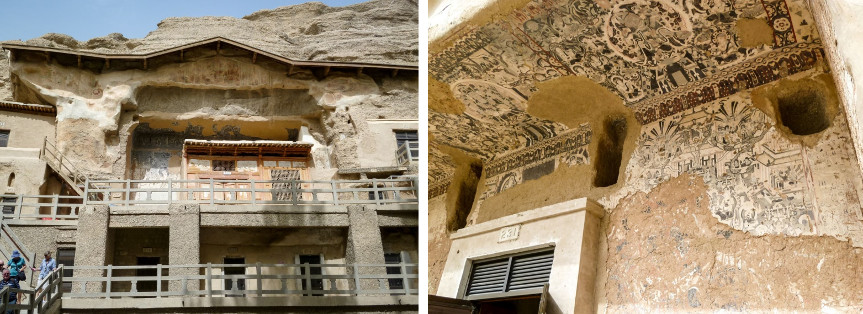
View some of finest examples of Buddhist art over 1000 year period; first used in 366AD as places of worship and meditation.
Discovery of 11th century manuscripts walled up in the Library Cave, with “works ranging from history, mathematics, folk songs, dances to religious Buddhist, Taoism, Nestorian (ancient religious beliefs), Christianity and Manichaeism (ancient dualist belief) documents” in Chinese, Khotanese, Sanskrit, Sogdian (extinct language of Central Asia origin), Tibetan, Old Uyghur, Hebrew and Old Turkic.
Thousand year-old murals from 5th to 14th century extensively covered 46,000 square metres (490,000 square feet), fully painted walls and ceilings; with strong Indian and Central Asian influenced painting techniques.
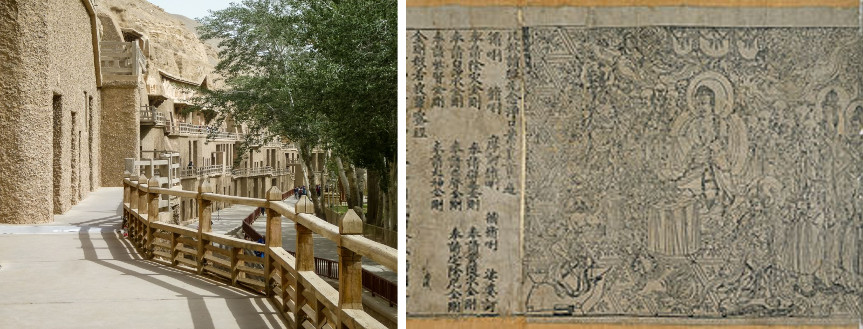
There are around 2400 clay sculptures, largest at 35.5m (116.6feet) high, damaged and repaired due to numerous earthquakes.
More than a thousand paintings on silk, banners, embroideries were discovered in the Library Cave mostly from Tang Dynasty reflected Chinese, Indian, Tibetan and Uighur styles; and source of early woodblock printing. The Chinese Diamond Sutra, oldest known dated printed book in the world, sits in British Library (Or.8210/P.2).
The art and story-telling pictorials, intricate details in carvings, immense statues created for continuity throughout time, indicated dedication and diversity of peoples who travelled along the land route of Chinese Silk Road, from Turkey in the West to eastern Chinese city of X’ian.
Without these paintings, structures and monuments, history would be forgotten, the past lost in the past.
Avoid visits in summer, as temperatures soar to high 40⁰C (104⁰F) – very dry heat with little shade. But visit, you must, to appreciate the intermingling of people and cultures, sharing of knowledge – an insight on how people lived in those times.
